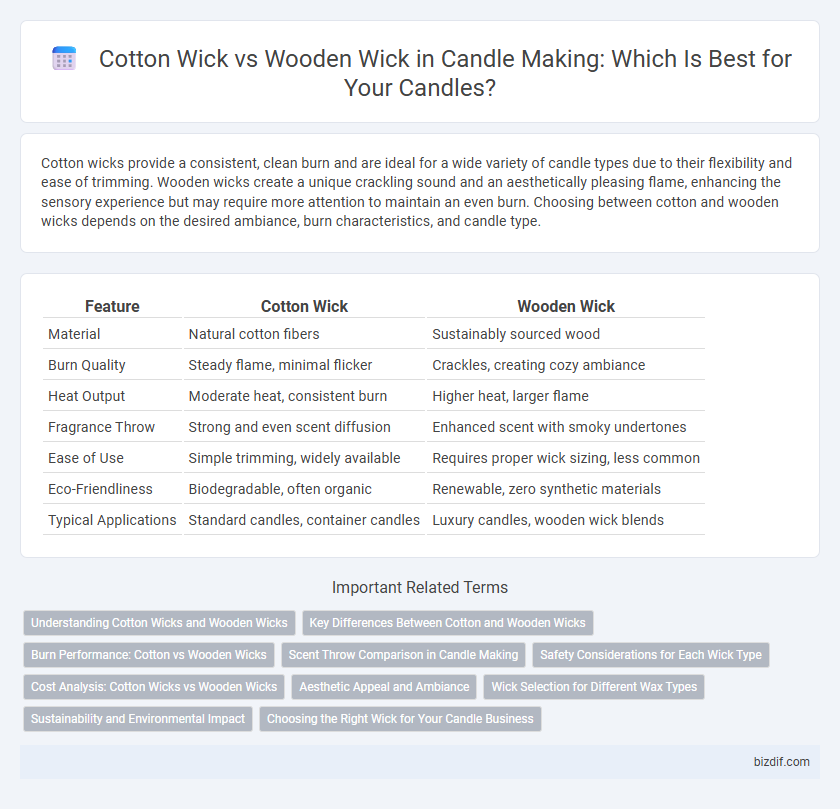Cotton wicks provide a consistent, clean burn and are ideal for a wide variety of candle types due to their flexibility and ease of trimming. Wooden wicks create a unique crackling sound and an aesthetically pleasing flame, enhancing the sensory experience but may require more attention to maintain an even burn. Choosing between cotton and wooden wicks depends on the desired ambiance, burn characteristics, and candle type.
Table of Comparison
| Feature | Cotton Wick | Wooden Wick |
|---|---|---|
| Material | Natural cotton fibers | Sustainably sourced wood |
| Burn Quality | Steady flame, minimal flicker | Crackles, creating cozy ambiance |
| Heat Output | Moderate heat, consistent burn | Higher heat, larger flame |
| Fragrance Throw | Strong and even scent diffusion | Enhanced scent with smoky undertones |
| Ease of Use | Simple trimming, widely available | Requires proper wick sizing, less common |
| Eco-Friendliness | Biodegradable, often organic | Renewable, zero synthetic materials |
| Typical Applications | Standard candles, container candles | Luxury candles, wooden wick blends |
Understanding Cotton Wicks and Wooden Wicks
Cotton wicks, made from braided or twisted cotton fibers, offer a clean, steady flame ideal for most candle types, providing consistent burn times and minimal soot. Wooden wicks, crafted from thin wood strips, create a unique crackling sound and a broader flame, adding an aesthetic and sensory element to candle burning. Both wick types require specific wax compatibility and wick sizing to ensure optimal performance and safety in candle making.
Key Differences Between Cotton and Wooden Wicks
Cotton wicks provide a consistent and steady flame, ideal for holding fragrance and delivering a clean burn with fewer soot emissions, whereas wooden wicks create a distinctive crackling sound and wider flame that enhances ambiance but may burn faster. Cotton wicks are more flexible in sizing, suitable for various candle diameters, while wooden wicks require specific widths to ensure even burning and prevent tunneling. The choice between cotton and wooden wicks impacts burn time, flame characteristics, and overall candle performance, influencing scent throw and user experience.
Burn Performance: Cotton vs Wooden Wicks
Cotton wicks offer a consistent and even burn with minimal crackling, making them ideal for providing steady flame performance in candle making. Wooden wicks create a unique ambiance by producing a soft crackling sound that mimics a fireplace, though their burn rate can be faster and may require more frequent trimming. Choosing between cotton and wooden wicks depends on desired burn time, aesthetic preferences, and the type of wax used for optimal candle performance.
Scent Throw Comparison in Candle Making
Cotton wicks generally provide a more consistent and stronger scent throw in candle making due to their even burn and better wax melting properties. Wooden wicks, while offering a unique crackling ambiance, tend to produce a softer scent throw because their burn characteristics can create cooler flames and uneven wax pools. Choosing between cotton and wooden wicks depends on the desired balance between fragrance intensity and sensory experience.
Safety Considerations for Each Wick Type
Cotton wicks offer consistent burn rates and minimal flickering, reducing soot production and lowering fire hazards in candle making. Wooden wicks require careful sizing and trimming to prevent excessive flame height and uneven burning, which can increase the risk of overheating and wax spillage. Proper wick selection and maintenance are critical for ensuring safe candle performance and preventing accidents related to wick type.
Cost Analysis: Cotton Wicks vs Wooden Wicks
Cotton wicks generally cost less than wooden wicks, making them a more budget-friendly choice for candle makers, especially in bulk production. Wooden wicks tend to be more expensive due to the additional processing and materials involved, but they offer a unique aesthetic and crackling sound that can justify the higher price. Evaluating overall cost involves considering both wick price and the impact on candle burn time and fragrance throw, where wooden wicks often provide longer performance, potentially offsetting their initial higher cost.
Aesthetic Appeal and Ambiance
Cotton wicks produce a classic, steady flame that complements traditional candle designs, offering a warm and consistent glow ideal for cozy environments. Wooden wicks create a unique crackling sound and a wider, flickering flame, enhancing ambiance with a rustic, contemporary aesthetic. Choosing between cotton and wooden wicks fundamentally shapes the candle's visual impact and the sensory experience it delivers.
Wick Selection for Different Wax Types
Cotton wicks are ideal for soy and paraffin waxes because they provide a consistent burn and minimal soot, enhancing fragrance throw and candle longevity. Wooden wicks, preferred for beeswax and gel wax candles, create a unique crackling sound and produce a wider flame, improving ambiance and aesthetics. Selecting the appropriate wick ensures optimal combustion, prevents tunneling, and maximizes the candle's performance based on the wax type used.
Sustainability and Environmental Impact
Cotton wicks are biodegradable and often sourced from organic cotton, making them a sustainable choice with minimal environmental impact. Wooden wicks, derived from natural wood, provide a renewable option that burns cleaner and produces less soot, contributing to improved indoor air quality. Both wick types support eco-friendly candle making, but wooden wicks offer an added advantage by using sustainably harvested wood, reducing reliance on agricultural resources.
Choosing the Right Wick for Your Candle Business
Choosing the right wick is essential for candle making success, with cotton wicks offering a clean, consistent burn ideal for traditional candles, while wooden wicks provide a unique crackling sound and contemporary aesthetic that attracts niche markets. Cotton wicks are best suited for soy and beeswax candles due to their flexibility and optimal flame height, whereas wooden wicks excel in eco-friendly and decorative candles, enhancing customer experience with their visual and auditory appeal. Understanding the wax type, scent throw, and target audience helps candle businesses select the perfect wick, maximizing burn performance and product satisfaction.
Cotton wick vs Wooden wick Infographic

 bizdif.com
bizdif.com